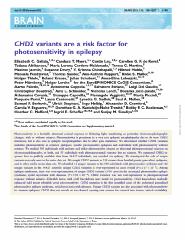Please use this identifier to cite or link to this item:
https://ahro.austin.org.au/austinjspui/handle/1/12691| Title: | CHD2 variants are a risk factor for photosensitivity in epilepsy. | Austin Authors: | Galizia, Elizabeth C;Myers, Candace T;Leu, Costin;de Kovel, Carolien G F;Afrikanova, Tatiana;Cordero-Maldonado, Maria Lorena;Martins, Teresa G;Jacmin, Maxime;Drury, Suzanne;Krishna Chinthapalli, V;Muhle, Hiltrud;Pendziwiat, Manuela;Sander, Thomas;Ruppert, Ann-Kathrin;Møller, Rikke S;Thiele, Holger;Krause, Roland;Schubert, Julian;Lehesjoki, Anna-Elina;Nürnberg, Peter;Lerche, Holger;Palotie, Aarno;Coppola, Antonietta;Striano, Salvatore;Gaudio, Luigi Del;Boustred, Christopher;Schneider, Amy L ;Lench, Nicholas;Jocic-Jakubi, Bosanka;Covanis, Athanasios;Capovilla, Giuseppe;Veggiotti, Pierangelo;Piccioli, Marta;Parisi, Pasquale;Cantonetti, Laura;Sadleir, Lynette G;Mullen, Saul A ;Berkovic, Samuel F ;Stephani, Ulrich;Helbig, Ingo;Crawford, Alexander D;Esguerra, Camila V;Kasteleijn-Nolst Trenité, Dorothee G A;Koeleman, Bobby P C;Mefford, Heather C;Scheffer, Ingrid E ;Sisodiya, Sanjay M | Institutional Author: | EuroEPINOMICS CoGIE Consortium | Affiliation: | Department of Paediatrics, University of Washington, USA NIHR Biomedical Research Centre Department of Clinical and Experimental Epilepsy, UCL Institute of Neurology, National Hospital for Neurology and Neurosurgery, Queen Square, London, UK North East Thames Regional Genetics Laboratories, Great Ormond Street Hospital for Children NHS Foundation Trust, London, UK NIHR Biomedical Research Centre Department of Clinical and Experimental Epilepsy, UCL Institute of Neurology, National Hospital for Neurology and Neurosurgery, Queen Square, London, UK 2 Epilepsy Society, Bucks, UK Department of Medical Genetics Research, University Medical Centre Utrecht, The Netherlands. Luxembourg Centre for Systems Biomedicine, University of Luxembourg, Esch-sur-Alzette, Luxembourg. Department of Neuropaediatrics, University Medical Centre Schleswig-Holstein and Christian-Albrechts-University of Kiel, Kiel, Germany. Cologne Centre for Genomics, University of Cologne, Cologne, Germany. Danish Epilepsy Centre, Dianalund, Denmark 10 Institute for Regional Health Services, University of Southern Denmark, Odense, Denmark. Department of Neurology and Epileptology, Hertie Institut for Clinical Brain Research, Tübingen, Germany. Folkhälsan Institute of Genetics and Neuroscience Centre, University of Helsinki, Helsinki, Finland Research Programs Unit, Molecular Neurology, University of Helsinki, Helsinki, Finland Wellcome Trust Sanger Institute, Wellcome Trust Genome Campus, Hinxton, Cambridgeshire, UK Institute for Molecular Medicine Finland, University of Helsinki, Helsinki, Finland Program in Medical and Population Genetics and Genetic Analysis Platform, The Broad Institute of MIT and Harvard, Cambridge, USA Epilepsy Centre, Neurology Department, Federico II University of Naples, Naples, Italy Department of Child Neurology, Paediatric Clinic, Clinical Centre Nis, Serbia Department of Paediatric Neurology, Paediatric Clinic, Al Sabah Hospital, Kuwait Neurology Department, The Children's Hospital Agia Sophia, Athens, Greece Epilepsy Centre 'C. Poma Hospital', Mantova, Italy Department of Child Neurology and Psychiatry C. Mondino National Neurological Institute, Via Mondino, 2, 27100, Pavia, Italy Brain and Behaviour Department, University of Pavia, Pavia, Italy Neurophysiopathology Unit, San Filippo Neri Hospital, Rome, Italy Child Neurology, NESMOS Department, Faculty of Medicine and Psychology, Sapienza University, Rome, Italy Neurorehabilitation Unit, Department of Neuroscience and Neurorehabilitation, IRCCS, Bambino Gesu' Children's Hospital, Rome, Italy Department of Paediatrics and Child Health, School of Medicine and Health Sciences, University of Otago, Wellington, New Zealand Florey Institute of Neurosciences and Mental Health, and Department of Paediatrics, University of Melbourne, Royal Children's Hospital, Melbourne, Australia Department of Medicine, Austin Health, The University of Melbourne, Heidelberg, Victoria, Australia Epilepsy Society, Bucks, UK Chemical Neuroscience Group, Biotechnology Centre of Oslo, University of Oslo, Oslo, Norway Laboratory for Molecular Biodiscovery, University of Leuven, Leuven, Belgium Department of Medical Genetics Research, University Medical Centre Utrecht, The Netherlands |
Issue Date: | 17-Mar-2015 | Publication information: | Brain : A Journal of Neurology 2015; 138(Pt 5): 1198-207 | Abstract: | Photosensitivity is a heritable abnormal cortical response to flickering light, manifesting as particular electroencephalographic changes, with or without seizures. Photosensitivity is prominent in a very rare epileptic encephalopathy due to de novo CHD2 mutations, but is also seen in epileptic encephalopathies due to other gene mutations. We determined whether CHD2 variation underlies photosensitivity in common epilepsies, specific photosensitive epilepsies and individuals with photosensitivity without seizures. We studied 580 individuals with epilepsy and either photosensitive seizures or abnormal photoparoxysmal response on electroencephalography, or both, and 55 individuals with photoparoxysmal response but no seizures. We compared CHD2 sequence data to publicly available data from 34 427 individuals, not enriched for epilepsy. We investigated the role of unique variants seen only once in the entire data set. We sought CHD2 variants in 238 exomes from familial genetic generalized epilepsies, and in other public exome data sets. We identified 11 unique variants in the 580 individuals with photosensitive epilepsies and 128 unique variants in the 34 427 controls: unique CHD2 variation is over-represented in cases overall (P = 2·17 × 10(-5)). Among epilepsy syndromes, there was over-representation of unique CHD2 variants (3/36 cases) in the archetypal photosensitive epilepsy syndrome, eyelid myoclonia with absences (P = 3·50 × 10(-4)). CHD2 variation was not over-represented in photoparoxysmal response without seizures. Zebrafish larvae with chd2 knockdown were tested for photosensitivity. Chd2 knockdown markedly enhanced mild innate zebrafish larval photosensitivity. CHD2 mutation is the first identified cause of the archetypal generalized photosensitive epilepsy syndrome, eyelid myoclonia with absences. Unique CHD2 variants are also associated with photosensitivity in common epilepsies. CHD2 does not encode an ion channel, opening new avenues for research into human cortical excitability. | Gov't Doc #: | 25783594 | URI: | https://ahro.austin.org.au/austinjspui/handle/1/12691 | DOI: | 10.1093/brain/awv052 | Journal: | Brain | PubMed URL: | 25783594 | Type: | Journal Article | Subjects: | eyelid myoclonia with absences photosensitive seizure |
| Appears in Collections: | Journal articles |
Files in This Item:
| File | Description | Size | Format | |
|---|---|---|---|---|
| 25783594.pdf | 463.43 kB | Adobe PDF |  View/Open |
Page view(s)
72
checked on Mar 10, 2025
Download(s)
158
checked on Mar 10, 2025
Google ScholarTM
Check
Items in AHRO are protected by copyright, with all rights reserved, unless otherwise indicated.
